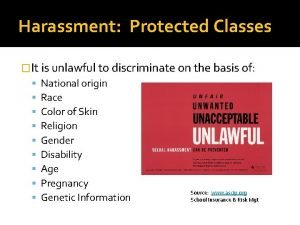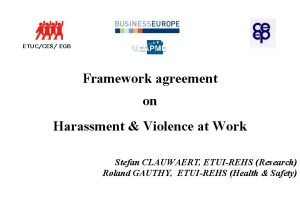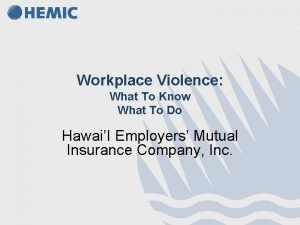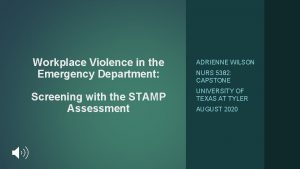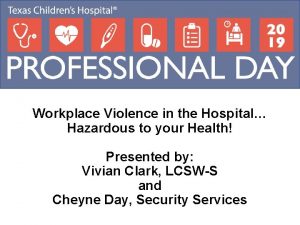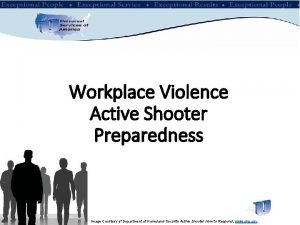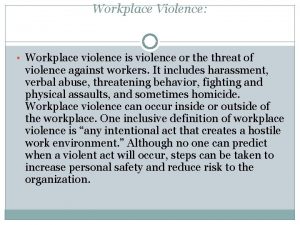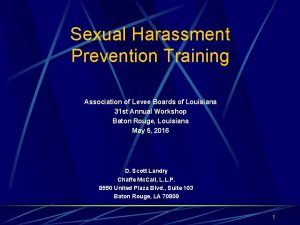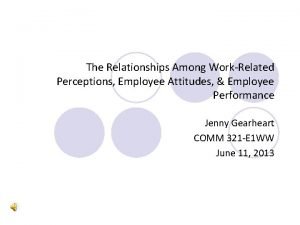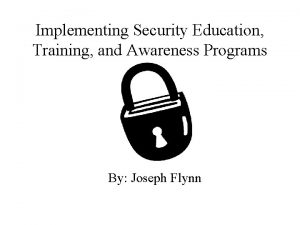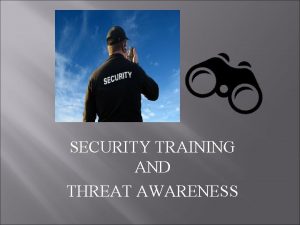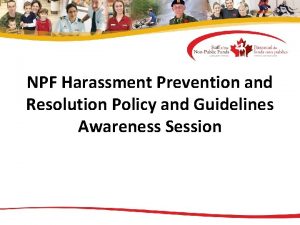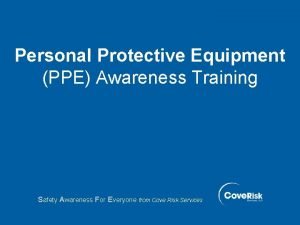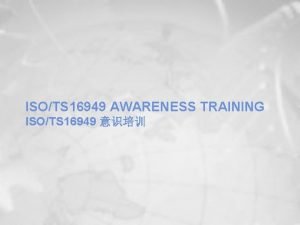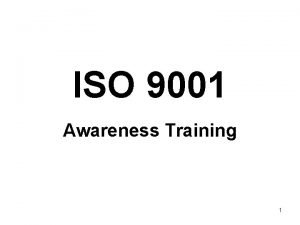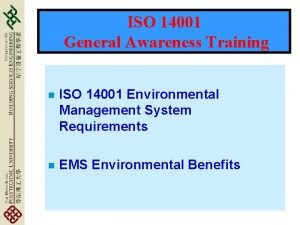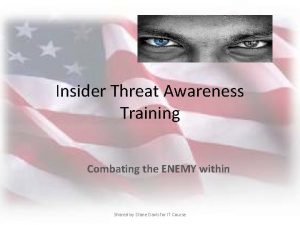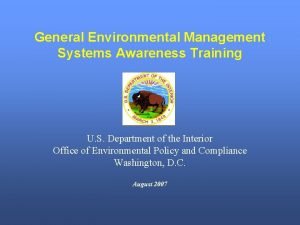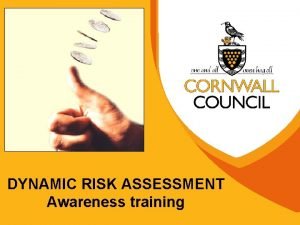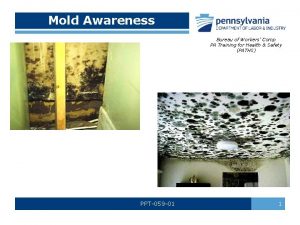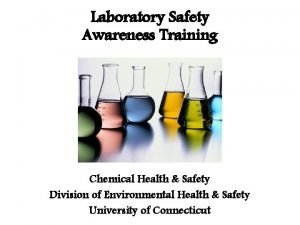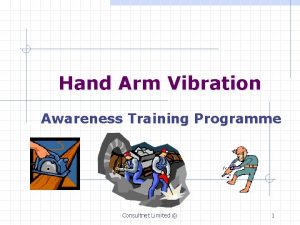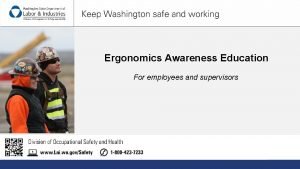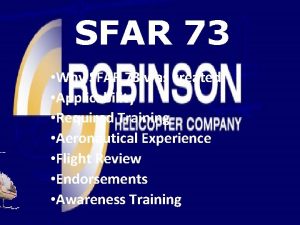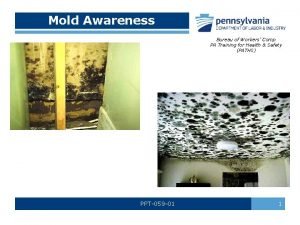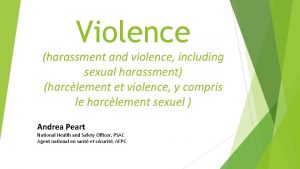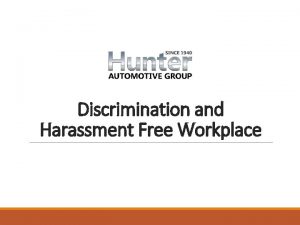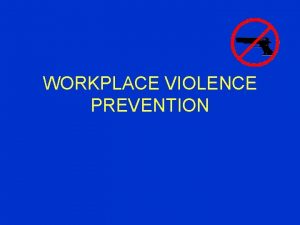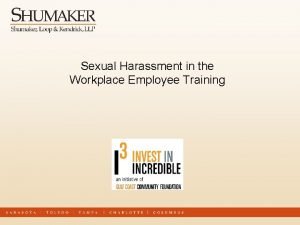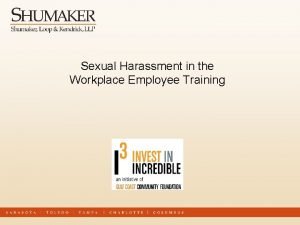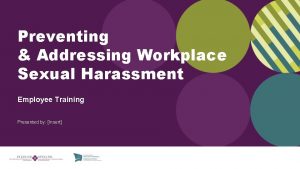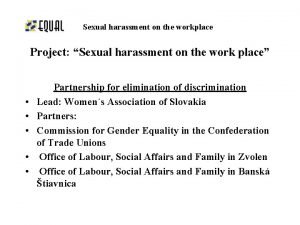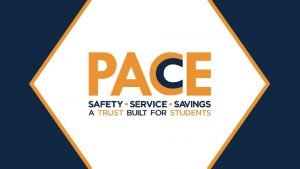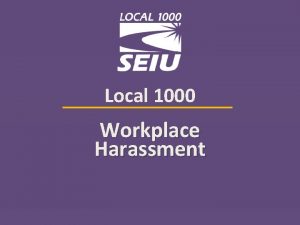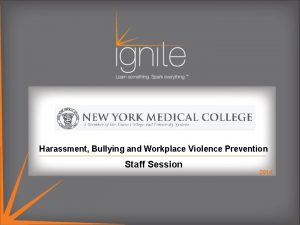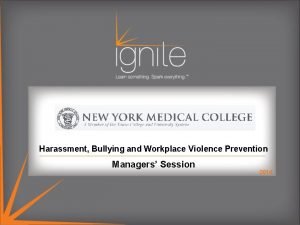Workplace Violence and Harassment Awareness Employee Training Learning













































- Slides: 45

Workplace Violence and Harassment Awareness: Employee Training

Learning Objectives To increase understanding of workplace violence and harassment; Understand the role of different players and their responsibilities; Understand existing YMCA policies and available resources; What to do if you have experienced, witnessed or become aware of unacceptable behaviour; Explore methods to reduce and prevent the risk of conflict and violence.

“Any attempt to impose your will on another is an act of violence. ” Gandhi

Introduction As an occupational health and safety hazard, violence in Canadian workplaces has been propelled from relative obscurity in the 1980’s to one of today’s leading health and safety problem.

Occupational Health and Safety Act Enforcement of the Act; Powers of Ministry of Labour inspectors; Co-operate with inspectors; Significant penalties if found guilty; Individuals the Organizations

YMCA Workplace Health Approach Value Policy

Occupational Health & Safety at the YMCA of Greater Toronto ”Management of the YMCA of Greater Toronto is vitally interested in providing a work environment in which all individuals are treated with respect and dignity. YMCA of Greater Toronto aims to provide and maintain a constant and continuing interest in Health and Safety matters including Accident Prevention, Safe Working Practices, healthy and safe work environment and duty of care for all members. We strive to be a valued member of our communities. Safety is a prime and foremost consideration in every decision made and every action taken. ” YMCA Health & Safety in the Workplace Notice

Workplace Violence “The exercise of physical force by a person against a worker in a workplace that causes or could cause physical injury to the worker, An attempt to exercise physical force against a worker in a workplace that could cause physical injury to the worker, A statement or behavior that is reasonable for a worker to interpret as a threat to exercise physical force against the worker, in a workplace, that could cause physical injury to the worker. ” Ontario Occupational Health & Safety Act

Workplace Violence Includes: Threatening behaviour - shaking fists, destroying property or throwing objects; Verbal or written threats - any expression, remarks of an intent to inflict harm; Verbal abuse – rumors, swearing, arguments, insults or condescending language; Physical attacks - hitting, shoving, pushing or kicking, disruptive behavior; Words and actions that hurt people; Any words or actions where the intention or impact is to cause pain, fear, or hurt.

“The YMCA of Greater Toronto is committed to building and preserving a safe working environment for its employees. In pursuit of this goal, the YMCA does not condone and will not tolerate acts of harassment and/or violence against or by any YMCA volunteer or staff. This pertains to workplace violence and harassment on YMCA worksites including but not limited to offsite meetings or conferences, social situations related to work. ” YMCA Workplace Violence and Harassment Policy

Workplace Harassment is improper or vexations conduct which is known or ought reasonably to be known to be unwelcome. The conduct may be: • • • Unwelcome Intimidating Threatening Coercive Demeaning, belittling, offending or humiliating May happen one time or in a continuing series of incidents Sexual Harassment is improper conduct that meets the definition of harassment that is sexual in nature. It may be a physical, or a comment, or gesture that is unwelcome.

Definitions: Harassment Psychological Harassment, also called psychological violence, mobbing or bullying, can be described as: • An extreme and damaging form of harassment • Behaviour that is often intentional, malicious and intimidating causing harm to victims and bystanders • Using words or gestures as opposed to physical force to cause harm • Behaviour that often escalates into physical violence

Workplace Harassment Definition of workplace harassment is broader than the definition of harassment under the Ontario Human Rights Code as it is not limited to prohibited grounds of discrimination such as race, sex, etc.

Harassment Examples • • • Demeaning or sexually oriented jokes, cartoons, gestures, persistent teasing, taunting or unwanted nicknames Displaying or distributing offensive material or images including electronic sharing of inappropriate internet sites, memes, cartoons etc. Derogatory comments including slurs Shunning or exclusion Verbal abuse or threats Unwelcome physical contact, comments or gestures Stalking Mimicking of person’s physical differences or disabilities Repeated unwanted social requests, propositions, advances or flirtation Unwelcome or suggestive looks, sexist jokes Inappropriate comments, postings etc. on social media.

Obligation: Create a safe Environment Under OHSA we are required to create a safe work environment, which includes having a complaints resolution process, and to address issues as soon as we are reasonably aware. New Legislation effective September 2016 Ø Employers have additional duties with respect to workplace harassment, including a requirement to appropriately investigate workplace harassment (including sexual harassment) incidents and complaints and new accountabilities for reporting outcomes Ø Employees may now contact the Ministry of Labour directly if they feel an investigation was inadequate.

Domestic Violence A person who has a personal relationship with a worker such as: a spouse, current or former intimate partner, a family member, may physically harm or attempt or threaten to physically harm that worker at work. In these cases domestic violence is considered workplace violence.

Who Do Victims Tell at Work? (Source: Healthcare Domestic Violence Network) 66% of victims tell someone at work: – Immediate supervisor (59%) – Co-worker (46%) – Another supervisor (6%) – Human resource professional (1%) Victims don’t disclose because: – They consider it to be a personal issue – Feel embarrassed or ashamed – Do not believe people at work can be trusted – Fear of losing job or other negative consequences – Partner works in same workplace

Myths about Workplace Violence MYTH: Violence just happens; someone just snaps! FACT: There are usually warning signs that occur over a period of time.

Why People Turn To Violence Money Power Self Esteem Respect

Four Major Sources of Workplace Violence Co-worker: The individual is or has been employed in the workplace. Member: The individual is a member for whom the YMCA provides services. External/ Intrusive Stranger: The individual is a stranger with no valid relationship to the workplace. Personal/ Family: Violence related to (current or former) personal or domestic relationship taking place into the workplace.

Types of Threats Direct threat Veiled threat Conditional threat Implausible threat

Legal Duties: Employers and Supervisors Employers and supervisors, have the duty to ensure employees work in compliance with the Occupational Health and Safety Act and to take all precautions reasonably necessary to protect the health and safety of the worker.

Supervisors are responsible for: Assessing the risk of violence to employees in their work area, minimizing those risks where necessary or reasonably possible, and informing any affected employee of such risk or potential risk. They are responsible for ensuring that employees are trained to: Recognize the potential for violence Follow the procedures and policies developed to minimize or control risks Respond to incidents appropriately Report and document such incidents Participate in the investigation process YMCA Workplace Violence and Harassment Policy

Employees are responsible for: Informing their supervisors of any violence, potential risk of violence, or harassment they may experience or witness. This includes: Co-operating with the police, YMCA or third party investigators or other authorities as required during any investigation related to workplace violence or harassment. Working in compliance with this policy and any supporting programs or policies. YMCA Workplace Violence and Harassment Policy

Right to Refuse Work Due to Violence or Threat of Violence A worker can refuse to work or particular task where he or she has reason to believe that, any equipment, machine, device or thing the worker is to use or operate is likely to endanger himself, herself or another worker; the physical condition of the workplace or the part thereof in which he or she works or is to work is likely to endanger himself or herself; workplace violence is likely to endanger himself or herself; or any equipment, machine, device or thing he or she is to use or operate or the physical condition of the workplace or the part thereof in which he or she works or is to work is in contravention of this Act or the regulations and such contravention is likely to endanger himself, herself or another worker. Ontario Occupational Health and Safety Act

Work Refusal Process As per the Ontario Occupational Health & Safety Act: Two-stage process; Two standards for assessing legitimacy of refusal; Fine line between insubordination and legitimate work refusal; Worker may not be required to specifically invoke the Act.

Work Refusal – Stage One At the Worker Refuses to Work Because Staff has Reason to Believe Work Endangers Health and Safety Staff reports problem to Supervisor Staff Representative Called In Supervisor Investigates in Presence of Staff and Worker H&S Representative Does Supervisor Agree that the Situation Endangers Health or Safety NO YES Does Staff Have Reasonable Supervisor Takes Grounds to Believe Work Corrective Action Endangers Health or Safety Staff Returns to Work

Work Refusal – Stage Two At the Does Staff Have Reasonable Grounds to Believe Work Endangers Health or Safety NO Staff Returns to Work YES Inspector Called Staff May Be Assigned Reasonable Alternative Work May Be Offered to Another staff in Presence of Worker H&S Rep. Reason of Refusal Must Be Discussed Investigator Investigates in Consultation with Staff Employer and Worker H&S Rep. Written Decision by MOL Corrective Action if Ordered

Information, Training and Instruction All staff should: know the YMCA Health and Safety in the Workplace and YMCA Workplace Violence and Harassment policies; know how to get immediate assistance; know how to report complaints, incidents of workplace violence to the supervisor and to fill out the accident/incident report; know, understand be able to carry out the measures and procedures that are in place to protect them from workplace violence.

Continuum of Violence usually is the end result of an escalation of conflict. Hostility/Violence Anger Blame Frustration Confusion



Recognize RECOGNIZE inappropriate behavior An employee tells another employee “I’m sick of your shit” and pushes him against the wall. What should you do?

Common Reasons for not Reporting “Why you might notice or report an incident? ” ü “That’s just Bob being Bob. ” ü Want to avoid confrontation ü Intimidating employee ü “I don’t want my team to look bad. ” ü Other excuses? ? ?

Why Report Remember, by reporting threats or acts of workplace violence, you could save lives EVEN YOUR OWN!

How To Handle a Workplace Violence Situation: The principles involved are similar to ones used to deal with other occupational health and safety hazards: identify the problem; solve it using a preventative focus; involve the workers affected, and then monitor the effectiveness of the preventive intervention.

In Communication and Conflict Resolution Workplace Violence (Awareness, Response and Prevention) Quick Reference Guide contains suggestions for improving your communication and conflict management skills including: ü Communicating with Confidence ü Resolving Conflict ü Improve Your Listening Skills

What Do Supervisors Need to Manage Policy; Threat Assessment Procedure; Workplace Violence Response Procedure.

What Tools Do You Have? YMCA Workplace Violence and Harassment Violence Policy; YMCA Health and Safety in the Workplace policy; Awareness component Power. Point presentation Prevention component Workplace Violence Workbook : A Guide for YMCA Leaders Workplace Violence Awareness, Response and Prevention Guide Workplace Violence and Harassment Training Acknowledgement for Staff Emergency response checklist Response component Guidelines for individual action plan; Individual action plan form; Hazard Assessment toolkit Follow-up checklist for supervisors; Guidelines for Supervisor’s Dealing With Domestic/ Family Violence.

Threat Assessment Procedure Investigate the Threatening Situation Gather Information; Make an Assessment; Evaluate the Threat Make an Assessment; Manage the Threatening Situation Develop an Action Plan; Implement the Action Plan.

Persons with a History of Violent Behaviour The duties of Employers and Supervisors extends to include the duty to provide information, including personal information, related to a risk of workplace violence from a person with a history of violent behaviour, but only if, the worker can be expected to encounter that person in the course of his or her work; and the risk of workplace violence is likely to expose the worker to physical injury. No employer or supervisor shall disclose more personal information in the circumstances than is reasonably necessary to protect the worker from injury.

Individual Safety Action Plan Assist employees to develop a workplace and personal safety plan to reduce the risk of a violent situation in the workplace.

In Summary • WHY: To ensure that the YMCA of Greater Toronto is in compliance of legislation pertaining to Workplace Violence and Harassment. • HOW: By Referring to and utilizing available resources and consulting your supervisor. • What: Follow the YMCA policies and procedures.

Resources • • • www. ccohs. ca/ www. osha. gov www. cdc. gov/niosh http: //www. wsib. on. ca/ http: //www. labour. gov. on. ca The Canadian Centre for Occupational Health and Safety Occupational Safety and Health Administration Centers for Disease Control and Prevention Workplace Safety and Insurance Board Ontario Ministry of Labour

Remember Safety is everybody’s responsibility!
 Workplace violence and harassment quiz answers
Workplace violence and harassment quiz answers Bullying and harassment training resources
Bullying and harassment training resources Framework agreement on harassment and violence at work
Framework agreement on harassment and violence at work Privacy awareness and hipaa privacy training cvs
Privacy awareness and hipaa privacy training cvs Workplace harassment oregon
Workplace harassment oregon Sexual harassment at workplace act nepal
Sexual harassment at workplace act nepal Indicators of potential workplace violence
Indicators of potential workplace violence Indicators of potential workplace violence
Indicators of potential workplace violence Stamp violence assessment tool
Stamp violence assessment tool Liz kelly continuum of violence
Liz kelly continuum of violence De-escalation worksheet
De-escalation worksheet Workplace violence
Workplace violence Dhs workplace violence
Dhs workplace violence Type 3 workplace violence
Type 3 workplace violence Bullying and harassment training presentation
Bullying and harassment training presentation Louisiana sexual harassment training
Louisiana sexual harassment training Have i been sexually harassed quiz
Have i been sexually harassed quiz Wsu sexual harassment training
Wsu sexual harassment training Employee attitudes and employee performance
Employee attitudes and employee performance Security education and training programs
Security education and training programs Suspicious mail training
Suspicious mail training Hipaa privacy and security awareness training
Hipaa privacy and security awareness training Policy on harassment prevention and resolution
Policy on harassment prevention and resolution Introduction to employee training and development
Introduction to employee training and development Teta accredited providers list
Teta accredited providers list Learning english through workplace communication
Learning english through workplace communication Cuadro comparativo e-learning m-learning b-learning
Cuadro comparativo e-learning m-learning b-learning Iso 9001:2015 ppt
Iso 9001:2015 ppt Level 3 cjis security test
Level 3 cjis security test Abuse prevention training quiz answers
Abuse prevention training quiz answers Ppe awareness training
Ppe awareness training Ppe awareness training
Ppe awareness training Sogedac
Sogedac Iso awareness training for employees
Iso awareness training for employees 17 elements of iso 14001
17 elements of iso 14001 Insider threat awareness training
Insider threat awareness training Environmental management system awareness training
Environmental management system awareness training Dynamic risk assessment
Dynamic risk assessment Mold awareness training
Mold awareness training Chemical sensitivity symptoms
Chemical sensitivity symptoms Dysphagia symptoms
Dysphagia symptoms Hand arm vibration awareness training
Hand arm vibration awareness training Ergonomics awareness training for supervisors
Ergonomics awareness training for supervisors Ergonomics awareness training for supervisors
Ergonomics awareness training for supervisors Sfar 73 explained
Sfar 73 explained Mold awareness training
Mold awareness training
